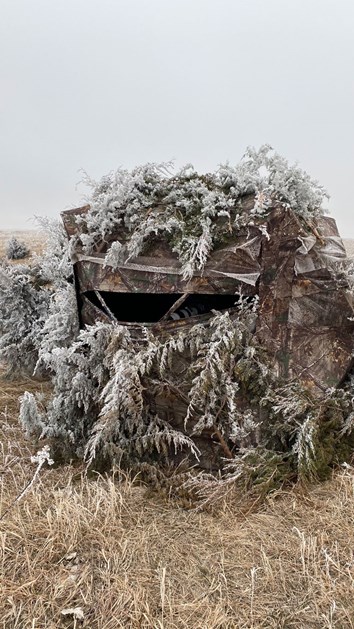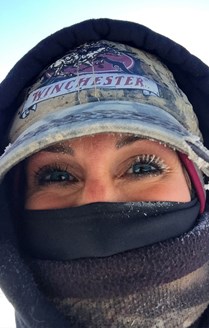Staying warm late in the season can be a difficult task, but it can be done. The following tips didn’t come from reading online reviews … It came from sitting in minus 30 degrees Fahrenheit temperatures with blistering wind chills, all in hopes of bagging a big buck. Now, about 15 years into hunting at more than 200 days a year as my job, I can tell you—through trial and error— I’ve learned a thing or two about staying warm.


One sit at a time, year after year, I have found new ways to keep myself warm in the field so I can make the most of late-season hunting. As a rule, South Dakota winters are a brutal combination of frigid temperatures and a lot of wind. I’ve had my eyelashes frozen, truck doors iced shut, winter wind and cold advisories and white out conditions, but hunting through it all has proven very beneficial over the years. Some of my biggest bucks have come late in the season and staying warm and comfortable is critical to keeping it fun and enjoyable.
Thermacare Wraps
Thermacare wraps were created for people with back pain; however, years ago I started using them to keep warm, and it’s been a game changer. The wrap designed for the lower back works well over a base layer. It will stay warm for about 18 hours (and has no scent), so it never dies out or fluctuates in temperature throughout the day. It wraps around your stomach and keeps your lower back warm, where your kidneys are so that your blood flow stays warm keeping your entire body much warmer. They also make a neck wrap, which I put on underneath my neck gaiter.
Thermacare wraps are also great for sleeping in a tent in sub-zero conditions. Another tip for staying warm in a sleeping bag is to place a thermos of boiling hot water at the foot of your sleeping bag. This helps add a little extra heat for several hours and is something that you can usually find in camp.
Boot Blankets 
There is nothing fun about having cold feet. This is the number one complaint many people have when hunting in cold weather. I wear my regular DSG rubber boots that I use all season, but when the temps drop, I bring along a pair of boot blankets. They are essentially a big pillow that zips around your foot. I usually wipe off my boot if there is snow or water on them, put the boot blanket on, then drop a couple of hot hands in each boot blanket, zip them up, and I can sit in a chilly stand all day.
Tote Tamers
Another key to keeping warm is staying dry. If you’re hunting day after day, one thing to watch out for is moisture in your boots or clothes. My rubber boots will get wet after a few days from sweat, even in cold conditions. I like to drop the Wildlife Research Center Tote Tamers in my boots at night and another set in a bin of my clothes to dry everything out. They don’t need to be charged and are very affordable, so it’s an easy way to keep everything dried out without having to drag a boot dryer along. I’ve also ruined many hairdryers trying to quickly dry boots out before leaving in the morning, so I can attest that this works much better!
Layers
Everyone knows the importance of layering, but sometimes people forget the main reason why: to take them off. The reason for layering is to prevent sweating. If you sweat, you will get cold. If you start sweating on your walk to the treestand, quit walking, take off a few layers and then continue on.
Heater
If you’re hunting in an enclosed blind or ground blind, heaters are a great option. Some people run them non-stop to keep their blind toasty warm, but if you’re gun hunting, you may run into trouble when opening the window with your scope fogging over. My suggestion is to turn it on every once in a while to cut the cold.
Hot Hands 
These are another handy heat source that can warm up your pockets, boot blankets or gloves. However, avoid using these directly on your skin, as they can burn you. Hot hands add a little extra heat and warmth to your hands and feet from time to time.
Neck Gaiter
I can’t remember the last time I hunted without a neck gaiter in my pack. Usually I keep two of them so one can be stuffed down around my neck, and the other can be pulled up over my face so only my eyes show. This really helps protect your face the harsh wind, rain and snow.
Hand Muff
I’m not a big fan of gloves most of the time, so I always have a hand muff wrapped around my waist when the temps get cold. In the morning I usually put a couple of disposable hot hands in the muff, and then stick my hands in there anytime they get cold.
Sling for Bow or Gun 
Anything beats hanging onto a cold gun or bow when the wind is howling. Your hands will get unbearably cold if you have to hold on to your bow or gun when walking. I highly recommend a sling so you can be hands free and keep those fingers warm either in mittens, a hand muff, or in your pockets.
















































